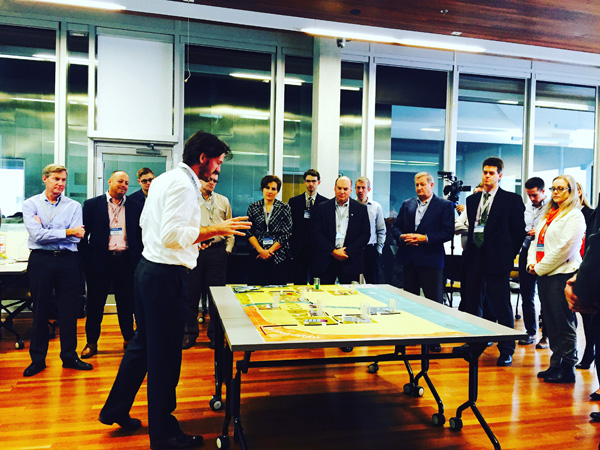 Wanna have some fun? Let’s play a game: You take some power stations, a control centre, and a scattering of battery banks. I’ll be a wily group of customers and LDCs, in alliance with a shifting collection of importers and local suppliers, vying for territory. We’ll throw in a few spot market traders, micro-grids, unscheduled outages, and restless industrial customers, tied together with some very thin lines. You have to keep the lights on, respond to new customer demands, and make money, while the world throws a relentless stream of surprises in your direction. Does that sound more like work or like play? More and more people may be asking the same question.
Wanna have some fun? Let’s play a game: You take some power stations, a control centre, and a scattering of battery banks. I’ll be a wily group of customers and LDCs, in alliance with a shifting collection of importers and local suppliers, vying for territory. We’ll throw in a few spot market traders, micro-grids, unscheduled outages, and restless industrial customers, tied together with some very thin lines. You have to keep the lights on, respond to new customer demands, and make money, while the world throws a relentless stream of surprises in your direction. Does that sound more like work or like play? More and more people may be asking the same question.
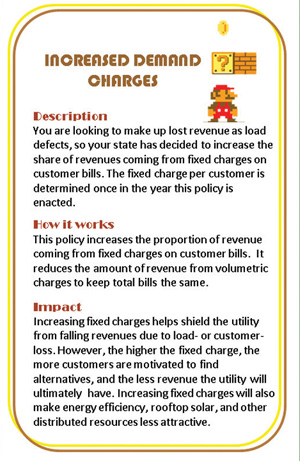 The power industry has always had to visualize scenarios. Many have used simulation games as part of their training processes. But never before has gaming been positioned to have the kind of impact on the energy system as it does today. Gaming has mushroomed in importance and uptake for three driving reasons: First because of its new reach thanks to digitization and internet connectivity, and second because of its integration with advanced behavioral science techniques yielding new insights into how customers interact with the energy system. Third, and certainly not least, with the energy industry on the edge of historic transitions, the need to visualize the impact of changes, and potential responses to them, has never been greater. Recognizing that game-playing has the potential to inspire creativity and be a catalyst for finding new solutions, professionals at various levels of the energy industry have been looking at new ways to harness the power of play.
The power industry has always had to visualize scenarios. Many have used simulation games as part of their training processes. But never before has gaming been positioned to have the kind of impact on the energy system as it does today. Gaming has mushroomed in importance and uptake for three driving reasons: First because of its new reach thanks to digitization and internet connectivity, and second because of its integration with advanced behavioral science techniques yielding new insights into how customers interact with the energy system. Third, and certainly not least, with the energy industry on the edge of historic transitions, the need to visualize the impact of changes, and potential responses to them, has never been greater. Recognizing that game-playing has the potential to inspire creativity and be a catalyst for finding new solutions, professionals at various levels of the energy industry have been looking at new ways to harness the power of play.
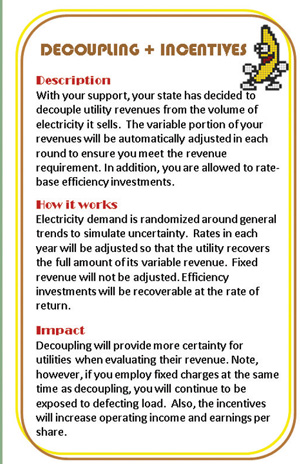 As in many other industries, the connections between the gaming sector and the power industry are impacting both fields, producing unexpected results and an over-riding sense that the greatest changes, and insights, are still ahead. In one case a utility has found that customers remember important details more clearly, making them better informed consumers, when well-designed games are used to enhance the relationship between utility and customer. In another case, energy companies have achieved striking results using gamification to enrich the understanding of system dynamics amongst professional staff responsible for asset management. For many companies, gaming can help them be more strategic in an increasingly competitive sector, and more responsive in key areas that are susceptible to disruption.
As in many other industries, the connections between the gaming sector and the power industry are impacting both fields, producing unexpected results and an over-riding sense that the greatest changes, and insights, are still ahead. In one case a utility has found that customers remember important details more clearly, making them better informed consumers, when well-designed games are used to enhance the relationship between utility and customer. In another case, energy companies have achieved striking results using gamification to enrich the understanding of system dynamics amongst professional staff responsible for asset management. For many companies, gaming can help them be more strategic in an increasingly competitive sector, and more responsive in key areas that are susceptible to disruption.
Likely a field in its infancy, energy sector game theorists are learning from these early initiatives, to design ever more sophisticated play-based interaction systems, the results of which can only be imagined at this stage.
Accelerated learning environments
A big reason for the appeal of gaming is that, “You end up learning concepts that stick in your imagination,” explains Andy Heppelle, a power industry professional with Capgemini. In one example he describes, Union Gas designed what it called “experiential learning processes” that enabled it to “accelerate the learning of new ideas” amongst staff, something that was critical for adapting to changes the company saw coming in the energy sector.
Recognition is growing that enhanced learning is fostered by integrating play into certain aspects of business. Perhaps a sign of the times, it appears that a new profession, related in part to the field of organizational change management, has been making headway in recent years. In one example, Conferences Connect, a group specializing in utility-oriented professional events, hosted the Utilities Gamification Conference in San Diego in 2014. Ashley Baptiste, the CEO of Conferences Connect, reports that several utilities, based both in the US and Canada, gained insights through their gaming experiences that would not likely have been available to them otherwise. Describing his experience, Andy Heppelle said, “I came away … with a list of rich connections and business opportunities that continue to provide value.”
Robert Feeney, Co-Founder and CEO of Ringorang, makes the case that a new generation of games are coming onto the market with significantly greater powers to stimulate engagement and learning, compared to what went before. The Ringorang app has been deployed by a number of energy companies in recent years with remarkable results. Using well-known behaviour psychology and learning methods, he explains that, “We’ve applied gamification in making it interesting and easy for people to return to critical information over and over. The app helps you maximize recall so that when situations come up, you’ve created a habit with sufficient repetition.” Company literature states that, “Ringorang is the #1 learning retention app. Using some simple gamification techniques, plus a patented engagement pattern known as Frequencing, this mobile and PC app consistently delivers 6x – 10x traditional engagement through emails and websites, and lifts traditional recall of key subjects from 21% to 83% or better.”
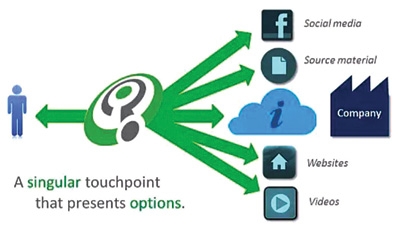
With online gaming, many aspects of human behavior can be tracked and measured systematically, an opportunity the energy industry has often overlooked. Utilities using the app have in fact documented remarkable improvements in customer engagement, in some cases 5 or 10 times the level of customer engagement compared to websites or emails from the same energy companies. With those results, utilities have been able to achieve hard-to-reach goals with their customers and employees alike. Mr. Feeney explains that “whether your goal is to ensure compliance or make a substantial change in behaviors or culture, you have to build habits. Games make it fun – and good games also make it simple, measurable and sustainable.”
Outlining some of the driving principles behind his company’s success, Mr. Feeney says that their app is fulfilling a need for “a different kind of learning science.” The main reason gamification became popular in the last ten years is that “the more we busy up our lives, the less time we have to engage in and retain learning.” There is a growing need to make information more interesting to digest, and to break it up in chunks along a learning path. In effect, Ringorang is delivering “a type of learning science that’s more suited to the way our brains naturally work, which is to adopt habits piece by piece, not in massed education formats.” This new type of learning science is becoming popularized as “micro learning,” he explains, noting that it “repairs the broken bridge between when you learn something and when you apply it. Reconnecting those through habit-building changes lives and entire organizations in a matter of months.”
CASE STUDY: Lighting Resources Inc. Uses Ringorang to Change Course
One of the largest U.S. lamp recyclers needed to make a change: with the advent of longer-lasting LED lights, the lamp recycling business was deteriorating. CEO, Dan Gillespie, was concerned he would lose talent and lose his business. He pushed his team to innovate ways to maximize equipment and resources, to recycle other materials such as airbags for auto manufacturers and retail returns for the large pharmacy chains. New opportunities appeared; however, Gillespie’s staff was conditioned to sell and process lamp recycling. They were not “change ready” – and that posed a risk to his new plan. Gillespie was competing for their attention paid to daily activities. So how could he develop new habits in his people to open their eyes to new revenue opportunities? Gillespie’s solution was to disseminate information that would gradually change their perception of their own organization. He bought a DIY license to the Ringorang app and customized his own program. At an annual gathering, he invited all managers nationwide to download the app and enter his private invite code. Then the game started, and his managers were alerted at seemingly random times each day to answer a game Q – a simple sequence of information that led to a “Learn More” article about what new opportunities were on the horizon and what goals needed to be met. The Series of weekly Challenges was called “Not Just Lamps” – and that message came through loud and clear and in a way that was fun for all. While the message was critical, the mode was enjoyable. The information shared became the equivalent of water-cooler talk in the organization, with managers playing against peers at their own facility and in other facilities around the country. It became a topic of daily discussion. The managers started asking the CEO key business questions about the details of his plans. The information delivered by the game clarified how each branch would be supported and incentivized. The change became real, and innovation resulted, including how to accommodate new markets, how to negotiate increased profit margins. A single branch brought on a key account in a new industry vertical that added 6% revenue to the entire organization in a couple of months. By the following year’s annual gathering, the organization celebrated the fact that they had significantly increased their revenues in a declining market.
New learning models help companies respond to change
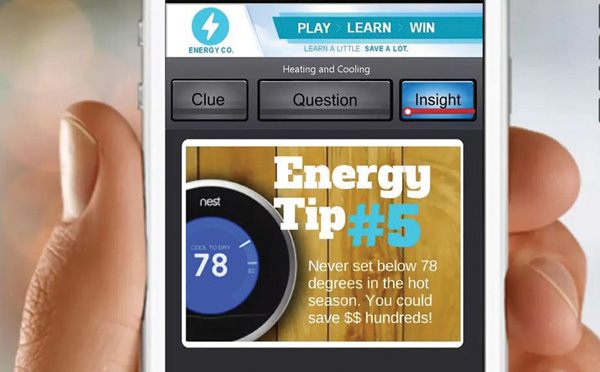
Energy Innovation, a policy consultancy based in California, has developed interactive computer models that simulate the energy sector going through transitions. In partnership with the research team of the National Association of Regulatory Utility Commissioners (NARUC), they are using one of the models to power a role playing game, in which participants see how their actions can affect important outcomes on the power grid. In a challenge that’s being called “MegaModels” for short, energy sector stakeholders team up in groups of 4-6 people to test different utility business models and play out rival strategies as choices are made about resource mix, infrastructure investments, and new policies.
Sonia Aggarwal of Energy Innovation explains that the game “Takes choices out of the abstract – and makes them meaningful for people.”
The game has been deployed in the halls of power in Washington DC, at the Energy Times Conference in Chicago, and elsewhere. Typical participants include public utility commissioners, their staff, utility executives, energy service providers, and IPPs. The objective is to perform well on four outcomes: reliability, carbon emissions, customer bill minimization, and utility financial performance. Each team is ranked on the four measures after each round and results are projected visually for all to see. Throughout the MegaModels game, players are encouraged to see current conditions from other participants’ perspectives.
The game also introduces unexpected events like a heat wave or a spike in gas prices. Such disruptions force players to muster their collective talents to solve problems much like in the real world. “It’s an opportunity to see how various business models interact with policy choices and unexpected events,” Aggarwal says. “Trying out options in a consequence-free environment helps drive deeper understanding.”
The Newtonian Shift
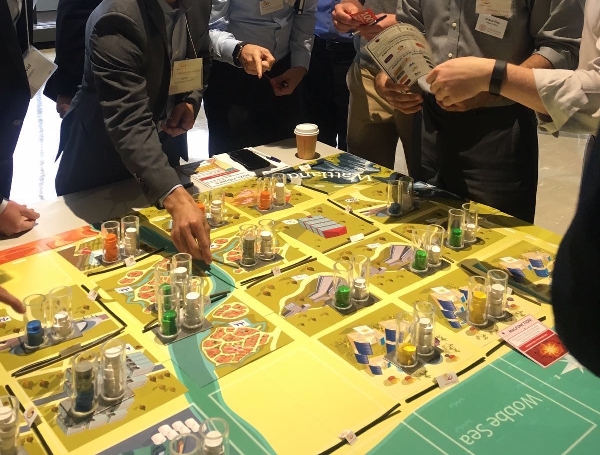 Figuring how to navigate in a crisis, positioning yourself for long-term success, looking for sources of stable value …. These actions may sound familiar to people in the power industry. They are widely used working goals. The game replicates key real life experiences. No doubt part of the appeal is the ability of a game to capture people’s interest and excite the imagination while retaining a focus on critical goals.
Figuring how to navigate in a crisis, positioning yourself for long-term success, looking for sources of stable value …. These actions may sound familiar to people in the power industry. They are widely used working goals. The game replicates key real life experiences. No doubt part of the appeal is the ability of a game to capture people’s interest and excite the imagination while retaining a focus on critical goals.
The MaRS Advanced Energy Centre (AEC) in Toronto is using Newtonian Shift, a room-sized board game for the energy sector, to help participants explore the complexity and dynamics of this changing energy landscape. In the process it’s become apparent that, unlike insights delivered through traditional conferences and meeting formats, participants in the game actively experience multiple years of sector transition in one day.
“Through fast-paced experiential learning, participants are immersed in the country of Newtonia, which finds itself in the middle of an energy transition. Energy must be supplied, energy assets developed and grids upgraded, all while balancing policy and regulation objectives, technology disruption, extreme weather events and new market entrants.” One organizer observes that, ”Newtonian Shift sets the stage for a dialogue around innovation, new alliances, the evolving needs of customers, and how your organization is preparing for the opportunities the energy transition will bring.”
One of the biggest points of value that players often take away from these workshops is being able to experience the transition from different perspectives. “I really got to live that role and gain a new respect for my clients’ perspective. This has confirmed our place in the market and where we want to push to,” remarked one player. Newtonian Shift allows participants to assume the role of and interact with diverse energy stakeholders, including private customers, large energy consumers, communities, utilities, suppliers, new market entrants, regulators and government.
Newtonian Shift can incorporate up to 30 different energy sector stakeholders in one session. However, the game can also be applied to assist a single company with its internal organizational development and strategy building. At the end of an enterprise level delivery, the AEC team produces a report summarizing the experience. The report can be used as input for a company’s strategic planning, with many participants applying game insights in developing major initiatives in their corporate strategy.
In fact, the originator of the game, the Dutch utility Eneco, has engaged large numbers of its own employees in several rounds of the game, to make sure the whole organization was aligned on plans for a strategic transition.
The Newtonian Shift has been used by companies on several continents, some of whom are household names. The AEC has delivered Newtonian Shift to almost 500 participants in Ontario, Chile and the United States. Rocky Mountain Institute (RMI), an energy think tank based in Colorado, is delivering the game to the US and has teamed up with the AEC to co-deliver multiple sessions in this market, including the California Independent System Operator (CAISO) and the New York Power Authority (NYPA). They are co-delivering the game to multiple entities in the U.S. market, and have together upgraded Newtonian Shift to better reflect the U.S. energy landscape.
RMI has used Newtonian Shift in the past to bring together key stakeholders to think creatively about the future of electricity under regulatory uncertainty and change. For example, the Electricity Innovation Lab (eLab) at RMI has played Newtonian Shift with several multistakeholder groups including at eLab member meetings and the VERGE conference in 2015. In October 2014 at West Point, New York, RMI hosted an eLab workshop for key stakeholders involved with the Reforming the Energy Vision (REV) initiative in the state. In this case, Newtonian Shift was used as a strategy simulation for representatives from organizations including the New York State Energy Research and Development Authority (NYSERDA), NY Smart Grid Consortium, New York State Department of Public Service, PJM Interconnection, Environmental Defense Fund, SunEdison, U.S. Navy, Sunverge Energy, NRDC, and Consolidated Edison Company. The Newtonian Shift is also available through the Energy Futures Lab, a “platform to discuss, experiment, and innovate,” based in Alberta.
In October 2015, in San Jose California, RMI facilitated a private session of Newtonian Shift during the annual VERGE Conference, as sustainability and technology forum hosted by GreenBiz. Participants in the game included: Oracle, NRG Energy, Burbank Water and Power, Environmental Defense Fund, Energy Excelerator, SunPower, Google, and Pacific Gas and Electric. The partnership between RMI and AEC is extensive. They have run the game separately on many occasions and co-delivered the game to U.S. stakeholders. They expect to continue with co-delivery, and have partnered with Fresh Forces (the original Eneco game designer) to co-design and co-produce a new version of the Newtonian Shift game, in which each organization has equal ownership.
In a related offering, the AEC also hosts a “Scenario Planning” process to help companies think through and describe different potential futures of the energy sector in 2030, and test the robustness of their own strategies against these possible futures. This process explores key trends and drivers of change affecting the sector, and helps participants envision alternative futures for how these could play out and impact their organization. To date this process has been used by 5 organizations in Ontario and New York for corporate strategy development.
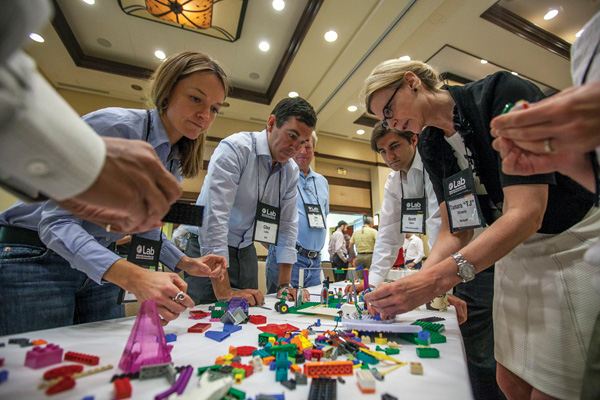 In some cases gaming exercises are a component of a broader planning or training project. For example, eLab at RMI utilizes Lego as a creative tool to help electricity professionals examine and experiment with the sector in novel ways. As part of the eLab Accelerator, an intensive multi-stakeholder project boot camp, participants use Lego blocks to collaboratively define and visualize desirable outcomes in energy sector resulting from their project work. Since 2012, eLab Accelerator has supported over 37 project teams advance cutting-edge work in the sector, including new utility business models, rate design and DER valuation, public policies, low-income solutions, and consumer engagement processes. The structure of the Lego game within the Accelerator allows for active coaching and exchanges between teams. Although the Accelerator event is focused on real world projects, the use of creative gaming and play offers insight and collaboration that would not be available to the process otherwise.
In some cases gaming exercises are a component of a broader planning or training project. For example, eLab at RMI utilizes Lego as a creative tool to help electricity professionals examine and experiment with the sector in novel ways. As part of the eLab Accelerator, an intensive multi-stakeholder project boot camp, participants use Lego blocks to collaboratively define and visualize desirable outcomes in energy sector resulting from their project work. Since 2012, eLab Accelerator has supported over 37 project teams advance cutting-edge work in the sector, including new utility business models, rate design and DER valuation, public policies, low-income solutions, and consumer engagement processes. The structure of the Lego game within the Accelerator allows for active coaching and exchanges between teams. Although the Accelerator event is focused on real world projects, the use of creative gaming and play offers insight and collaboration that would not be available to the process otherwise.
Is there sharp line between work and play?
Are these initiatives on the upswing because they are putting fun into the process of helping utilities connect with their customers? Or because they are tapping into basic understandings about human behavior? Or maybe because play and work are not really that separate after all?
It is possible that play is becoming more essential for companies in both competitive and regulated sectors, as a means of becoming ready for change, and more effective at adapting.
What are you going to do when an outage crops up in sector 7, or when customers start angling for alternative suppliers across service territory borders? How about if a new emission control treaty is signed in Capital City? You may learn the answer first when you start playing for real.
- By Jake Brooks, with thanks to the numerous contributors as mentioned in the text above and below.
For more information:
The Advanced Energy Centre video on the Newtonian Shift: https://youtu.be/OdOhGs_VwV8
Ringorang: https://ringorang.com
Rocky Mountain Institute eLab Accelerator: http://www.rmi.org/elab_accelerator
The Energy Innovation policy simulator: https://www.energypolicy.solutions/
Another game dealing with the relative impact and costs of different climate and energy policies, one that Bloomberg called “Minecraft for Energy Wonks.”
Conferences Connect can be reached at www.UtilityEvents.com
